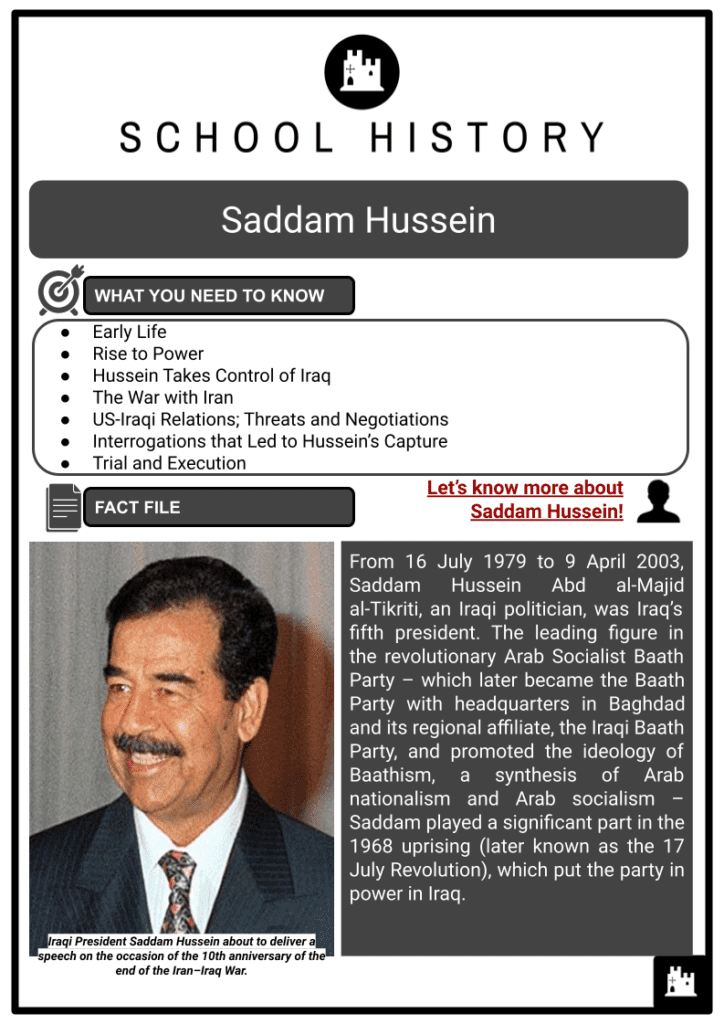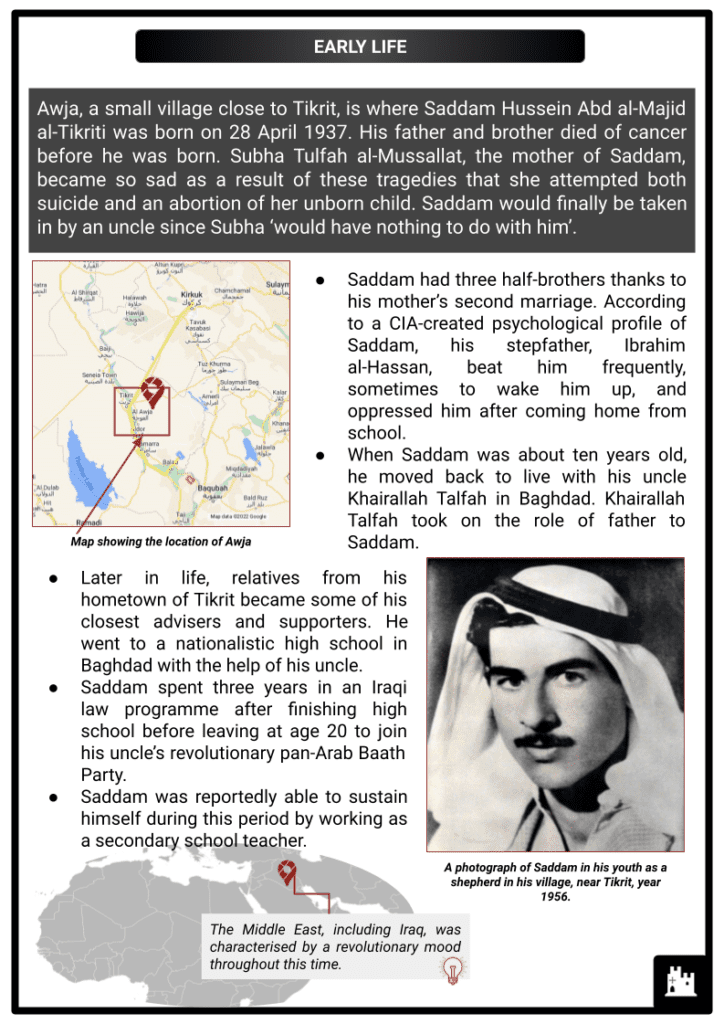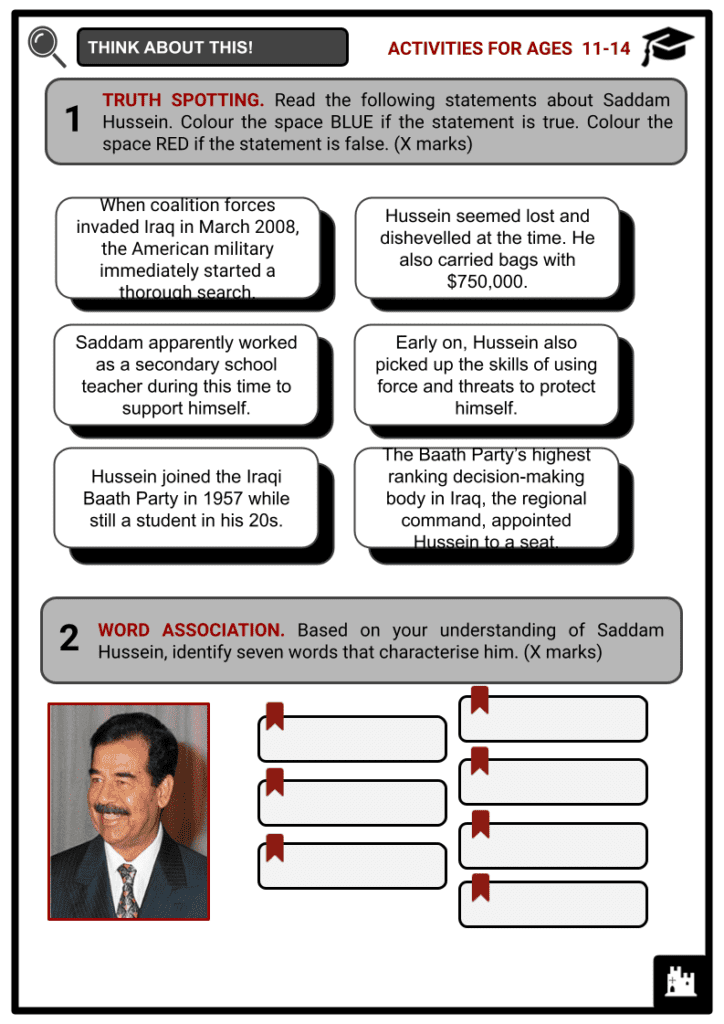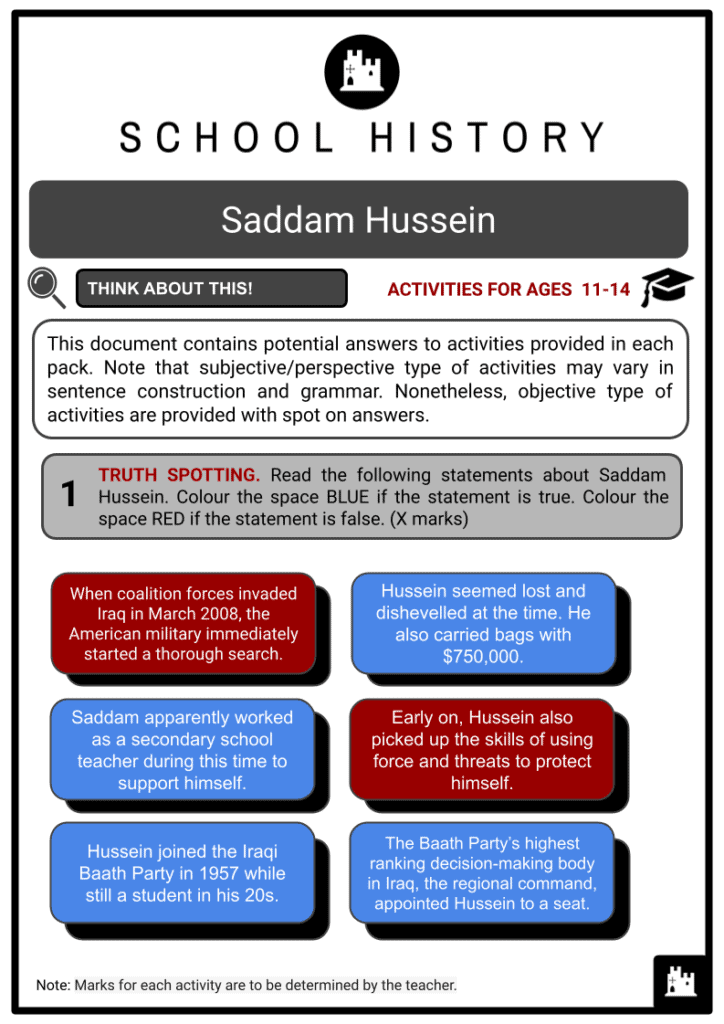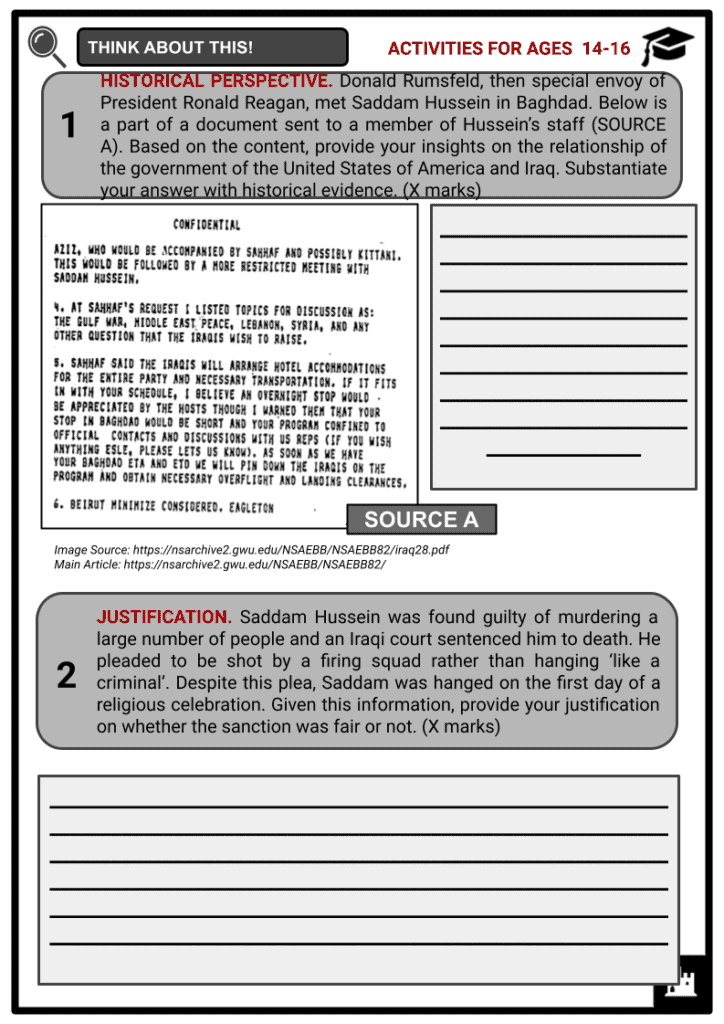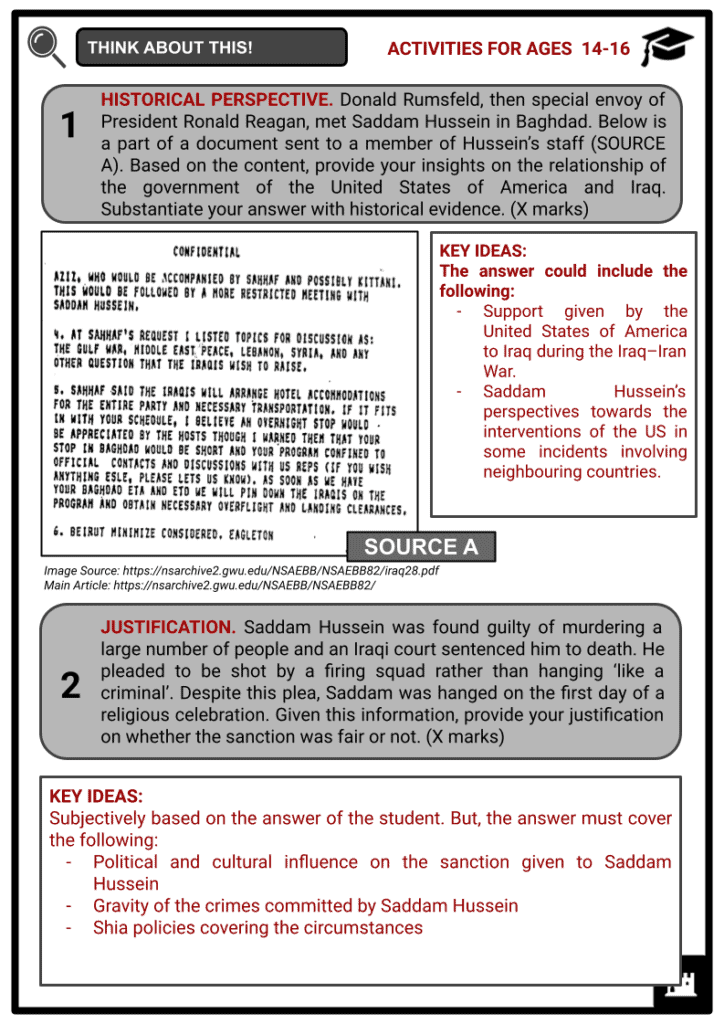Saddam Hussein Worksheets
Do you want to save dozens of hours in time? Get your evenings and weekends back? Be able to teach about Saddam Hussein to your students?
Our worksheet bundle includes a fact file and printable worksheets and student activities. Perfect for both the classroom and homeschooling!
Summary
- Early Life
- Rise to Power
- Hussein Takes Control of Iraq
- The War with Iran
- US-Iraqi Relations; Threats and Negotiations
- Interrogations that Led to Hussein’s Capture
- Trial and Execution
Key Facts And Information
Let’s know more about Saddam Hussein!
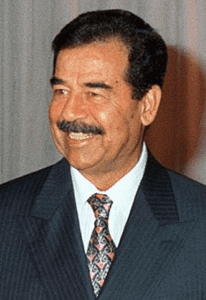
From 16 July 1979 to 9 April 2003, Saddam Hussein Abd al-Majid al-Tikriti, an Iraqi politician, was Iraq’s fifth president. The leading figure in the revolutionary Arab Socialist Baath Party – which later became the Baath Party with headquarters in Baghdad and its regional affiliate, the Iraqi Baath Party, and promoted the ideology of Baathism, a synthesis of Arab nationalism and Arab socialism – Saddam played a significant part in the 1968 uprising (later known as the 17 July Revolution), which put the party in power in Iraq.
EARLY LIFE
- Awja, a small village close to Tikrit, is where Saddam Hussein Abd al-Majid al-Tikriti was born on 28 April 1937. His father and brother died of cancer before he was born. Subha Tulfah al-Mussallat, the mother of Saddam, became so sad as a result of these tragedies that she attempted both suicide and an abortion of her unborn child. Saddam would finally be taken in by an uncle since Subha ‘would have nothing to do with him’.
- Saddam had three half-brothers thanks to his mother’s second marriage. According to a CIA-created psychological profile of Saddam, his stepfather, Ibrahim al-Hassan, beat him frequently, sometimes to wake him up, and oppressed him after coming home from school.
- When Saddam was about ten years old, he moved back to live with his uncle Khairallah Talfah in Baghdad. Khairallah Talfah took on the role of father to Saddam.
- Later in life, relatives from his hometown of Tikrit became some of his closest advisers and supporters. He went to a nationalistic high school in Baghdad with the help of his uncle.
- Saddam spent three years in an Iraqi law programme after finishing high school before leaving at age 20 to join his uncle’s revolutionary pan-Arab Baath Party.
- Saddam was reportedly able to sustain himself during this period by working as a secondary school teacher.
- During this time, progressives and socialists attacked the old political establishment in Iraq. Additionally, Gamal Abdel Nasser’s pan-Arab nationalism in Egypt significantly impacted young Baathists like Saddam.
- Nasser’s ascent marked the start of a wave of revolutions sweeping the Middle East during the 1950s and 1960s with the overthrow of the monarchy in Iraq, Egypt and Libya.
- By opposing the British and the French during the 1956 Suez Crisis, modernising Egypt, and bringing the Arab world together politically, Nasser encouraged nationalists throughout the Middle East.
- Khairallah Talfah, his uncle and later also his father-in-law, reportedly served five years in prison for battling the British in the Anglo-Iraqi War and the 1941 Iraqi coup d’état.
- He frequently served as a mentor to the young Saddam and told him
- In the 14 July Revolution, army officers under General Abd al-Karim Qasim deposed Iraq’s Faisal II in 1958, one year after Saddam joined the Baath Party.
RISE TO POWER
- In the 12 years that followed Hussein’s election as president of Iraq in 1979, his nation participated in two significant conflicts. The narrative of Hussein’s boyhood and ascent to power sheds light on his belligerent attitude towards his Middle Eastern neighbours.
- In Arabic, Saddam Hussein’s name translates to ‘one who confronts’, and he was born in 1937. He was raised by peasants close to the Sunni Muslim village of Tikrit, situated along the Tigris River about 100 miles (161 kilometres) north of Baghdad. To strengthen his reputation as a strong and brutal leader once he rose to power, Hussein created or exaggerated numerous aspects of his early life. Because of this, some details of his life are unknown.
- Hussein also learned early on to use violence and threats to accomplish his desires. He stated that he was ten years old the first time he killed someone.
- It is well known that Hussein murdered his brother-in-law during a heated family fight when he was a teenager and received a six-month prison sentence.
- As a student in his 20s, Hussein joined the Iraqi Baath Party in 1957. Baathism was a radical political movement established in the 1940s by Syrian revolutionary Michel Aflaq (Baath means ‘rebirth’ or ‘renaissance’ in Arabic).
- The more minor, unorganised Iraqi Baath Party was a part of this more significant movement. The majority of its members were brutal and vicious men who would do everything to seize power in Iraq.
- Hussein attempted to assassinate General Abdul Karim Qassem, the head of Iraq’s military, in 1959 as part of a gang of Baath revolutionaries (1914–1963).
- Hussein fled Iraq after the attempted assassination to avoid detention. He finally relocated to Cairo, Egypt, where he enrolled in a university and pursued a legal education after fleeing Syria.
- The Baath Party was victorious in toppling the Iraqi government in 1963. Hussein returned to Iraq as soon as the new administration entered power to assume his role.
- Hussein was given a seat in the Baath regional command, the party’s top decision-making body in Iraq, with the help of his older cousin Ahmed Hassan al-Bakr (1914–1982).
- The Baath Party immediately demonstrated to the people of Iraq that it was prepared to employ violence and threats to maintain its power.
- First, broadcasting Qassem’s dead body on Iraqi television demonstrated that the old leaders would not be returning. A Baath Party official pointed out the gunshot wounds in the dead general’s body before spitting in his face.
- The Baathists used the Iraqi royal palace as a torture facility for their adversaries throughout the following few months. Later, those surviving inmates reported that Hussein had personally interrogated and tortured them.
- Less than a year later, the Iraqi military succeeded in ousting the Baathists and regaining power. The military authorities imprisoned Hussein and numerous other Baath Party leaders.
- Hussein reflected on why his party had been unable to maintain control during his captivity. He believed that party officials had put excessive faith in the Iraqi military to back them up. He created his security unit within the party to prevent the Baathists from relying on the military to retake power. After serving two years in jail, Hussein broke out and joined the Baath Party as its security coordinator.
- He organised a sizable group that terrorised the populace and overthrew opposing political figures. The Baath Party again ousted the Iraqi government and took control of the country in 1968.
- Bakr was elected president of Iraq, while Hussein, his aspirational younger cousin, was elected vice-chairman of the Revolutionary Command Council of the party. Hussein oversaw internal security for the Baathist regime as well.
- Hussein rose to the position of being the most influential person in the country by using violence and threats to control the forces that assisted the party in maintaining power. During this time, he developed tight bonds with other party officials, but subsequently, to advance his career, he betrayed several of them.
- Although the Baathist administration concealed many of its violent actions, it occasionally used open shows of force to subdue its opponents. For instance, in January 1969, Iraq detained several international journalists and claimed they were Israeli agents. Seventeen of the journalists — 11 Jewish — were found guilty in open court and executed by hanging.
- Israel, a Jewish state in the Middle East, has a history of tense ties with several Arab nations. Thousands of Iraqis watched the killings take place in Liberation Square in Baghdad.
- During this time, Iraq continued to have the support of the United States and many European countries despite the Baathist government’s violent reputation and its disrespect for human rights.
- This friendly attitude was brought on by the Cold War, an economic and military battle between the United States, the Soviet Union, and allies.
- The goal of American foreign policy during the Cold War, which lasted from the 1940s to 1991, was to stop the spread of the Soviet Union’s communist system of government to other nations.
- With its emphasis on Arab nationalism (the aim of uniting the Arab world to establish one mighty nation), the United States saw the Baath movement as a viable alternative to communism. To maintain its sway in the Middle East, which was situated immediately south of the Soviet Union, the United States government needed to maintain excellent relations with Iraq.
HUSSEIN TAKES CONTROL OF IRAQ
- Hussein worked to expel Bakr’s supporters and his own Baath Party adversaries throughout the 1970s. He finally succeeded in ousting his cousin from power and taking over the administration in July 1979. Hussein reinforced his hold on power soon after taking office as president of Iraq by going on a murderous spree that left an estimated 500 people dead.
- Hussein once presided over an occasion that was shown on Iraqi television. Twenty prominent residents were hauled outside and executed for being traitors after he had them recite ‘confessions’ of crimes against the state.
- With the help of these cruel deeds, Hussein could win the Iraqi people over and maintain his total authority over the country. He understood that there were internal tensions among Iraq’s various ethnic and religious groupings and exterior threats from nearby nations.
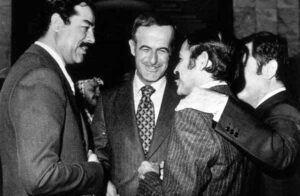
Syrian President Hafez al-Asad (centre) with Iraqi Vice President Saddam Hussein (left), Algerian Foreign Minister Abd al-Aziz Bouteflika (right) and Syrian Vice-President Abd al-Halim Khaddam (far right, half-covered) at the Arab League Baghdad Summit. - In response to these tensions, Hussein used violence to keep his grip on power and project an image of himself as a capable ruler who could lead the nation through its difficulties.
- Hussein also portrayed himself as an influential leader by plastering Baghdad with his pictures. For instance, his image could be seen in every town, school, hospital, and government office and on the sides of vehicles and buildings.
- He wanted the people of Iraq to sense his influence in their daily lives and accept his authority as the only option.
THE WAR WITH IRAN
- The 1980s, according to Hussein, would be a ‘glorious decade’ in which the people of Iraq would restore the honour of their country’s proud past. He wanted to make Iraq the most influential country in the Middle East and to install himself as the acknowledged leader of the Arab world. Hussein’s plan began with an attack on Iran, Iraq’s neighbour to the east.
- Iran was a non-Arab nation that had just experienced a revolution. The government was overthrown in 1979 by a group of Islamic fundamentalists (those who emphasise strict adherence to a set of religious beliefs) under the direction of a spiritual figure known as Ayatollah Khomeini (1900–1989).
- Khomeini, a Shiite Muslim, strongly opposed Hussein and his Sunni Muslim regime. Although Iran was larger than Iraq and had three times as many people as Iraq, Hussein believed that his well-trained armed forces could easily beat his foe. Sunni and Shiite are the two primary branches of Islam, with around 90% of all Muslims being Sunnis.
- The invasion of Iran by Iraq began in September 1980. First and foremost, Hussein wanted to take over the Shatt al-Arab canal. This critical access point to the Persian Gulf and part of the border between Iran and Iraq is where the Tigris and Euphrates Rivers converge.
- Even after the two nations had formally agreed to share the waterway in 1975, disagreements continued.
- The Iraqi invasion was greeted with ferocious resistance, surprising Hussein. After his troops were forced to retreat, he was compelled to request that the United Nations mediate a ceasefire deal. However, Khomeini promised to keep fighting his Sunni adversaries and refused to accept the ceasefire. There was almost continual fighting along the 730-mile (1,175-kilometre) border between the two countries for the entire eight-year duration of the Iran–Iraq War.
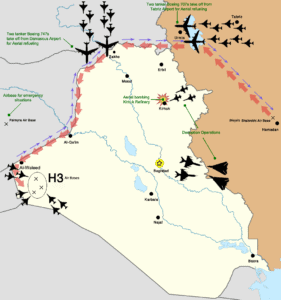
The surprise attack on an H-3 airbase is considered one of the most sophisticated air operations of the war. - President Reagan of the United States supported Iraq during the conflict. He and other American leaders were concerned that the Middle East may experience a proliferation of the religious fanaticism practised by the Iranian leadership. Additionally, they anticipated that by supporting Hussein, the Soviet Union — a Cold War foe of the United States — would be unable to get close to Hussein.
“Iraq has made clear its willingness, without preconditions, to negotiate an equitable settlement of the war and to implement U.N. Security Council Resolution 598. To date, Iran has refused to implement it. Meanwhile, by aggressive military action and terrorism, Iran has continued its efforts to intimidate the nonbelligerent nations of the Gulf, to close Gulf waters to neutral shipping, and to export a destabilizing blend of religion and politics in and even beyond the region.” - Statement of Pres. Ronald Reagan
- The United States initially supported Iraq only covertly. However, the United States revealed its allegiance to that side in 1984 when it established full diplomatic ties with Iraq. Kuwait, a small country south of Iraq, also supported Iraq.
- Like Iraq, Kuwait was governed by Sunni Muslims who opposed Iranian Shiites acquiring too much influence in the area. During the conflict, the government of Kuwait lent Iraq billions of dollars.
- Hussein’s forces frequently employed chemical weapons against Iranian forces during the conflict. Iraqi troops engaged the enemy with artillery shells that contained Tabun, a lethal nerve gas, or mustard gas, a blistering poison that could result in blindness or death. A set of international agreements, the Geneva Conventions, forbade using these and other chemical and biological weapons.
- Between 1864 and 1949, the conventions were created in Geneva, Switzerland. They are meant to ensure the humane treatment of enemy soldiers and detainees and the safety of civilians (those who are not engaged in combat, including women and children), both now and in the future. The use of chemical weapons by Iraq in violation of international law was condemned by the governments of the US and many other nations.
- The majority, however, were hesitant to participate, partly because several of the weapons used by Iraq were created with the assistance of American and European experts.
US-IRAQI RELATIONS; THREATS AND NEGOTIATIONS
- Between the conclusion of the Iran–Iraq War in 1988 and Iraq’s invasion of Kuwait in 1990, there were many ambiguous statements and miscommunications. Hussein tried to foresee how the world would react as he prepared to attack Kuwait. Given their track record of inaction, he grew to feel that the United States and other Western powers would not intervene.
- Meanwhile, foreign leaders misread Hussein’s motivations. They never anticipated that he would quickly initiate a conflict after the costly and destructive Iran–Iraq War. They failed to see many warning indications of Hussein’s ambitions because they wanted to keep good relations with Iraq.
- For instance, the United States and other nations condemned the use of chemical weapons by Iraq against the Kurds. Although Hussein received harsh criticism in the international media, hardly anything was done. In actuality, the situation was described as ‘an internal concern’ for Iraq in official US policy.
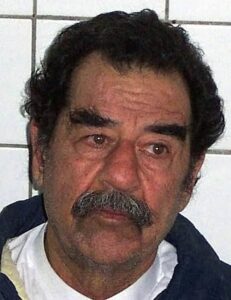
Hussein after being captured and shaved to confirm his identity - The human rights group Amnesty International also sent reports to the US government detailing human rights violations in Iraq. According to these allegations, the Iraqi government often executed political rivals and even tortured kids to extract information from their parents. However, in January 1990, the State Department conveyed official New Year’s congratulations on Iraq and stated its wish to strengthen their partnership.
- Hussein started issuing threats against other Middle Eastern nations.
- For instance, Hussein vowed that if Israel ever attacked Iraq, he would not think twice about using chemical weapons. As a result of the widespread anger caused by Saddam’s threat, some governments considered imposing economic sanctions (trade restrictions and other actions that harm a nation’s economy) as retaliation.
- Instead, in April 1990, the American government dispatched a delegation of lawmakers to meet with the Iraqi president in Baghdad. Senators Alan Simpson (1931–) of Wyoming, Senator Howard Metzenbaum (1917–2008) of Ohio, and Senator Robert Dole (1923–2021) of Kansas were among the group.
- The Iraqi government made public part of the meeting’s transcript, which was later broadcast on American television.
- This transcript gives the impression that the meeting was cordial and businesslike. The Iraqi account of the discussion does not include the comments that members of the American delegation afterwards said they had made regarding Hussein’s threatening rhetoric.
- Instead, the transcript suggested that the United States would watch from the sidelines if Iraq carried out its threats.
- Hussein vowed to use force against any Middle Eastern nation that exported too much oil in July 1990. Some of the largest underground oil reserves in the world are located in several Middle Eastern nations, including Kuwait and Iraq. These nations generate income by extracting and exporting oil (selling it to other countries worldwide). The world’s largest oil-exporting countries started the Organization of Petroleum Exporting Countries (OPEC) to coordinate oil output in 1960.
- To maintain steady oil prices, OPEC places caps, or quotas, on the amount of oil its members can produce annually. Kuwait, which had been pumping more oil than was permitted by OPEC agreements, was the target of Hussein’s threat.
- In a dynamic address on 17 July, Hussein charged Kuwait with taking crude from the Iraqi side of the South Rumaila oil field, which lay on both sides of the border between the two countries.
- Iraq’s Arab neighbours were also concerned about Hussein’s threats and army deployments against Kuwait. To mediate between Iraq and Kuwait, President Hosni Mubarak (1928–2020) of Egypt and King Hussein (1935–1999; governed Jordan from 1953 to 1999) organised diplomatic discussions. On 31 July senior Kuwaiti and Iraqi officials gathered in Saudi Arabia.
- Iraq threatened to invade Kuwait during these negotiations if the Kuwaiti government didn’t agree to several conditions.
- First, during the Iran–Iraq War, Kuwait loaned Iraq billions of dollars. Iraq contended that since it had battled Iran to defend all Arab interests in the Persian Gulf, it shouldn’t be required to pay back this money.
- Second, to maintain high oil prices on the global market, Iraq insisted that Kuwait restrict its oil production in the future.
- Finally, Iraq demanded that Kuwait relinquish control of the Persian Gulf island of Bubiyan. Hussein would have a strategic port on the gulf thanks to this sizable island off the southern coast of Iraq.
INTERROGATIONS THAT LED TO HUSSEIN’S CAPTURE
- The US military began an all-out search when coalition forces invaded Iraq in March 2003 and deposed its government. The target? The nation’s ousted tyrant, Saddam Hussein departed Baghdad as the capital was overthrown. Nine months later, American soldiers located Hussein close to his hometown of Tikrit and pulled him out during an operation known as Red Dawn.
- Hussein was dishevelled and lost at the time. He also had luggage with $750,000 and an unloaded Glock pistol that President George W Bush later retained as a souvenir. US military historians claim the team that captured Hussein included 600 men, 20 tanks and a squadron of Apache attack helicopters.
- Had it not been for the months of painstaking intelligence gathering and astute interrogation, all that firepower would have been meaningless.
- Without using a weapon, drone strikes or improved interrogation techniques, Eric Maddox, an Army interrogator attached to the Delta unit pursuing Hussein, played a critical part in the operation, regarded as the Iraq War’s most tremendous success.
- Much more cunningly, he employed empathy as his secret weapon to assist in determining Hussein’s precise whereabouts.
TRIAL AND EXECUTION
- On 30 June 2004, US forces detained Saddam Hussein and 11 other prominent Baathist figures at the US base Camp Cropper. Later, they were turned over to the Iraqi interim government so they might face trial for crimes against humanity and other offences.
- Following a botched assassination attempt against him a few weeks later, Saddam was indicted by the Iraqi Special Tribunal for crimes committed against the Dujail people in 1982.
- 148 individuals were allegedly murdered, women and children were reportedly tortured, and 399 others were unlawfully detained. Among the trial’s many difficulties were these:
- Saddam and his attorneys disputed the court’s legitimacy and insisted that he was still in office as president of Iraq.
- The murders and attempted murders of several of Saddam’s attorneys.
- Midway through the trial, the chief presiding judge was replaced.
- Saddam Hussein was found guilty of several crimes against humanity on 5 November 2006, and a hanging-verdict gave him the death penalty. Barzan Ibrahim, Saddam’s half-brother, and Awad Hamed al-Bandar, the chairman of the Iraqi Revolutionary Court in 1982, were both found guilty of related offences.
- The verdict and sentence were both challenging, but the Supreme Court of Appeals of Iraq ultimately upheld both decisions.
- On 30 December 2006, the first day of Eid ul-Adha, Saddam was hanged despite his desire to be shot. The execution took place in Camp Justice, a barracks for the Iraqi military in northeastern Baghdad’s Kadhimiya district. On a mobile phone video of the execution, Saddam’s captives could be heard insulting him.
- Iraqi National Security Advisor Mowaffak al-Rubaie and Iraqi Judge Munir Haddad have testified about how Saddam behaved when he was being led to the hangman. The two witnesses’ stories differ in that Haddad characterises Saddam as being courageous in his final moments, while al-Rubaie claims that Saddam was terrified.
Image Sources
- https://en.wikipedia.org/wiki/File:Saddam_Hussein_in_1998.png
- https://en.wikipedia.org/wiki/File:Hussein_Assad_Bouteflika_Khaddam.jpg
- https://www.wikiwand.com/en/Iran%E2%80%93Iraq_War#Media/File:Operation_H3_map.png
- https://en.wikipedia.org/wiki/File:Saddam_Hussein_captured_%26_shaven_DD-SD-05-01885.jpg

